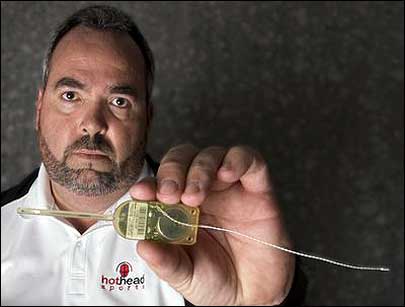Mar 20, 2009Atlanta-area high school football teams have completed trials of a helmet containing built-in RFID-enabled heat sensors that transmit a player's body temperature to coaches and trainers on the field. All five football teams, which have asked to remain unnamed, intend to permanently deploy the system when it becomes commercially available next month, according to Jay Buckalew, CEO of Hothead Technologies, which developed the system. In addition, the system is undergoing a second phase of study by independent researchers at Georgia's Kennesaw State University, in which subjects' core temperatures are compared against helmet temperature sensor data and transmitted to a handheld interrogator.
The objective of the technology is to protect athletes from heat stroke. Football coaches and certified athletic trainers currently have no sure way of determining when a player may be overheated. Symptoms of overheating include confusion, dizziness, headaches and nausea, but in some cases, players suffering from the condition might be entirely asymptomatic. For those playing in hot climates, such as in the southern United States, Puerto Rico, and Central and South America, the risk of heat stroke is higher and can be deadly. High school athletes are the most vulnerable, because so many are out on the playing field, with very few coaches or athletic trainers to keep an eye on their behavior or health condition.

The solution, tested this year by Georgia high school coaches and currently being researched at Kennesaw University, offers coaches and trainers their first automated look into the condition of each player. Hothead's Heat Observation Technology (HOT) system consists of a temperature sensor, made by General Electric's GE Sensing division, wired to an Identec Solutions battery-powered 915 MHz RFID transponder.
The sensor tags are embedded in the padded interior of football helmets made by Schutt, Riddell and Adams. The sensor is installed so that it makes contact with the skin over an artery on a player's temple. When the athlete dons the helmet, its sensor begins measuring the wearer's temperature. The transponder then transmits that data, along with the transponder's unique ID number, every five seconds. A Psion Teklogix Workabout Pro II handheld computer with a built-in RFID reader can receive and store that information from a tag up to 325 feet away. If the temperature rises above a predetermined threshold over the course of several transmissions, Hothead software, installed in the handheld reader, creates an alert to notify the trainer or coach on the sidelines.
The unique ID number of the helmet's sensor tag is linked to a specific player in the Hothead software. In that way, the Workabout Pro II displays the name of the player who may have overheated. The coach or trainer responding to the alert must press a prompt on the device to indicate he has received and is responding to that warning. Once the helmet is removed, the sensor detects a quick drop in temperature, and the system deduces that the player is no longer wearing the helmet and, thus, no longer physically exerting himself.
Making a transponder that would fit the helmet, accommodate the temperature sensor and sustain the rigors of football required some creative design work, says Peter Linke, Identec's president and CEO. "Football is one of the highest-impact activities there is," he states. "Getting any electronic device to work in that environment is challenging. We had to come up with a whole different housing to make it impact-resistant, and to fit it into a helmet. It had to be smaller, thinner, with a different battery and antenna, and it had to have an interface for the temperature sensor." The tag also needed to be able to transmit reliably on the field, in any weather, from fast-moving players.
Following the first phase of testing at Kennesaw State University, the technology is proving to work effectively, according to Laurie Tis, the college's associate dean and the leader of the research project testing Hothead's technology. In December 2008, the research team tested the system on five subjects. During the trial, temperature data from rectal probes were sent via a Wi-Fi transmission while the Hothead sensor readings from the helmet worn by the same subject were simultaneously transmitted via RFID. The resulting temperature differentials were compared in order to determine whether the Hothead sensors had been providing accurate temperature readings, as well as whether the RFID transponders had transmitted reliably.
The college research team has yet to test the system on a football field, Tis says, but the researchers—who tested it in a basement laboratory—found that the sensors measured the temperatures accurately and the tags transmitted reliably. They also found that the software accurately displayed the sensor results. Hothead has received the results of the first phase of the testing, he adds, noting, "The data is extremely tight. I think it's a good product, and the technology is very well built. They've done a lot of good work in research and development."
The research team is now studying the system in phase two with 30 subjects, Tis says, using the same testing methods. The results of the second phase of testing will be made public in approximately 12 months, he estimates.

